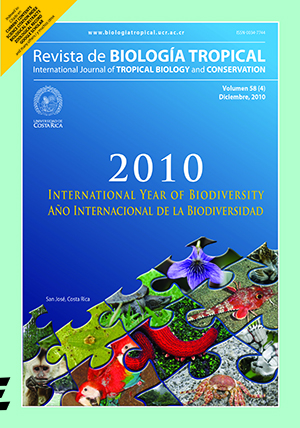Abstract
On a global level, Tropical Montane Cloud Forests constitute important centers of vascular plant diversity. Tree species turnover along environmental gradients plays an important role in larger scale diversity patterns in tropical mountains. This study aims to estimate the magnitude of beta diversity across the Tilarán mountain range in North-Western Costa Rica, and to elucidate the impact of climate and soil conditions on tree species turnover at a local scale. Seven climate stations measuring rainfall, horizontal precipitation (clouds and wind-driven rain) and temperatures were installed along a 2.5km transect ranging from 1 200m.a.s.l. on the Atlantic to 1 200m.a.s.l. on the Pacific slope. The ridge top climate station was located at 1 500m.a.s.l. Climate data were recorded from March through December 2003. Additionally, seven 0.05ha plots were established. On all plots soil moisture was monitored for one year, furthermore soil type and soil chemistry were assessed. Woody plants with a diameter at breast height (dbh) less than or equal 5cm were identified to species. Species distributions were explored by feeding pairwise Sørensen measures between plots into a Principal Component Analysis. Relationships between floristic similarity and environmental variables were analyzed using Mantel tests. Pronounced gradients in horizontal precipitation, temperatures and soil conditions were found across the transect. In total, 483 woody plants were identified, belonging to 132 species. Environmental gradients were paralleled by tree species turnover; the plots could be divided in three distinctive floristic units which reflected different topographic positions on the transect (lower slopes, mid slopes and ridge). Most notably there was a complete species turnover between the ridge and the lower Pacific slope. Floristic similarity was negatively correlated with differences in elevation, horizontal precipitation, temperatures and soil conditions between plots. It is suggested that beta-diversity in the study area is largely driven by species with narrow spatial ranges, due to the interactions between topography, climate and soil formation processes, especially around the wind-exposed and cloud covered ridge area. The findings emphasize the extraordinary conservation value of tropical montane cloud forests in environmentally heterogeneous areas at mid-elevations.##plugins.facebook.comentarios##

This work is licensed under a Creative Commons Attribution 4.0 International License.
Copyright (c) 2010 Revista de Biología Tropical
Downloads
Download data is not yet available.






